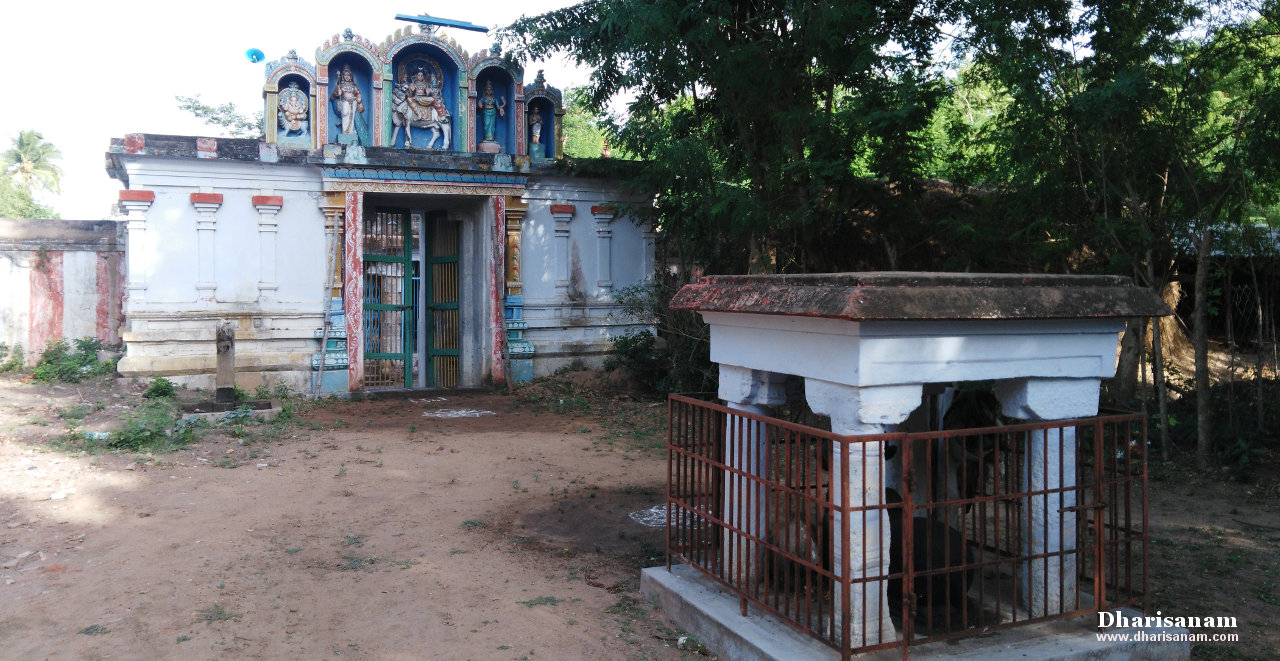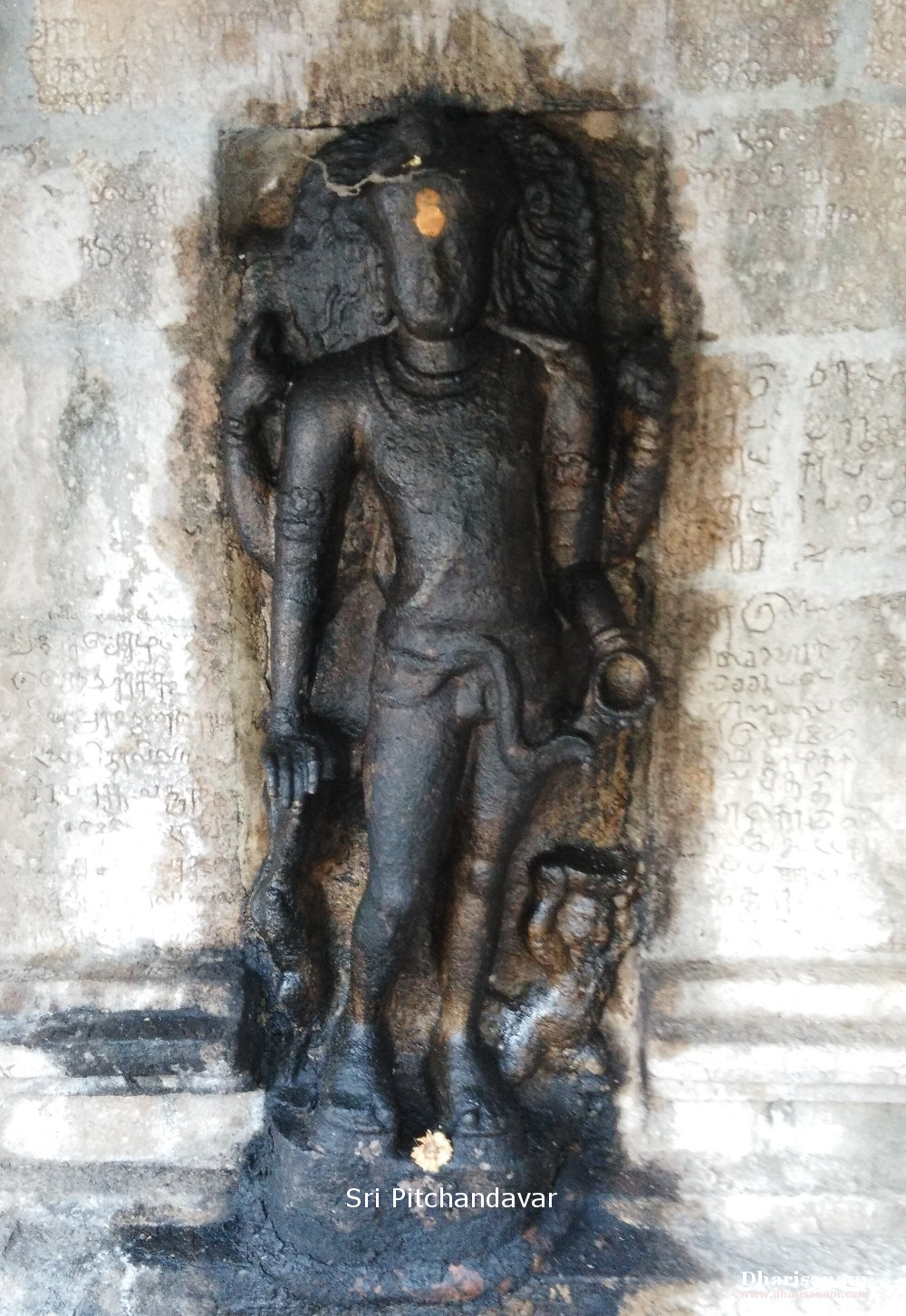Visited on: 11th June, 2018.
Location
Naalur Mayanam is situated at a distance of about 16 kms from Kumbakonam on the Kumbakonam to Kudavasal route (Via Thirucherai). After reaching Kudavasal, take diversion road from Athikadai bridge to Naalur and proceed further for about 2 kms to reach this place.
In Naalur, there is another Shiva temple, Sri Periya Nayagi with Sri Palasavaneswarar, which is a “Devara Vaippu Sthalam”. This is a Madakkoil built by king Kochengat Cholan.
Other Devara Paadal Petra Shiva Sthalam near this place are – Kalayanallur, Karukkudi, Sivapuram, Kudavasal, Naraiyur Siddheecharam, Thirucherai, Arisirkarai Puthur, Penu Perunthurai, Thalaiyalangaadu, Peruvelur, Karaveeram, Kaduvaikarai Puthur (Andankoil) and Thiru Kollamputhur.
General Information
| Moolavar | Sri Gnanaparameswarar, Sri Mayanathu Paramaswamy, Sri Mayanathu Moolathanathu Peruman |
| Ambal | Sri Gnanambigai |
| Theertham (Holy water) | Gnana Theertham |
| Sthala Vriksham (Sacred Tree) | Vilvam tree |
| Pathigam (Hymn) rendered by | Saint Thirugnanasambanthar-1 |
- This is one of the 276 Devara Paadal Petra Shiva Sthalams and 96th Shiva Sthalam on the Southern bank of the river Cauveri in Chozha Nadu (Thenkarai).
- Lord Shiva in this temple is a Swayambumurthi (self-manifested).
- This east facing temple has no main tower (Rajagopuram) but has a beautiful entrance with sculptures of Lord Shiva and Goddess Parvathy.
- The last consecration ceremony (Maha Kumbabishekam) took place on 24.01.2007.
History of the Temple
It is believed that this temple was originally built in the early Chola period and later on it was built using granite by Aditya Chola-I.
There are 23 stone inscriptions in this temple which date back to the periods of various Chola kings starting from Paranthaka Chola-I.
The historical names of this place are Chaturvedi Mangalam, Thirumayanam and Thirumeignanam.
This temple is under the administrative control of the Hindu Religious and Charitable Endowments Department of Government of Tamil Nadu (HR&CE).

Legend
There are four temples in the name of “Mayaanam” (burial ground) - they are
(1) Kachi Mayaanam (Kanchipuram),
(2) Veezhi Mayaanam (Thiruvizhimizhalai)
(3) Kazhi Mayaanam (Sirkazhi) and
(4) Naalur Mayaanam (this temple).
It is believed that Lord Mahavishnu, Brahma, the four Vedas, Aabasthamba Maharishi and Saint Thirugnanasambanthar have worshipped Lord Shiva here.
The Sanskrit word “Chaturvedi Mangalam” refers to the four Vedas. It is believed that the personified forms of these four Vedas worshiped the lord here. In Tamil this place is referred to as “Naal Vediyur” (“Naal” means four). Devotees believe that by worshiping the lord here, they can become Vedic scholars.
Deities in the temple
Other than the shrines of Lord Shiva and Goddess Parvathy, shrines and idols of Vinayagar, Murugan, a few Nagars, Chandikeswarar (2), Dakshinamurthy (2), Athma Lingam, Saneeswarar, Bairavar, Suryan and Navagraham can be seen in the hall and the corridors.
There is a separate shrine for Saint Thirugnanasambanthar in the main hall.
Shivalingams in the names of Sri Amirthakadeswarar, Sri Sattanathar, Sri Ekambareswarar and Veezhiazhagar can also be seen in the corridor.
In the “koshtam” (place surrounding the sanctum sanctorum), idols of Vinayakar, Pitchandavar, Natarajar, Karaikkal Ammaiyar, Dakshinamurthy, Mahavishnu, Brahma and Vishnu Durgai can be seen.










Salient Features
It is believed that a snake comes to this temple occasionally and wraps itself around the head of Shivalingam. Interestingly, while prising the lord of this temple, Saint Thirugnanasambanthar mentions the following line - “Paaloorum malai paampum panimadhiyum…..”. This means that the lord here is seen with a big snake.
Saint Thirugnanasambanthar also mentioned in his hymn that whoever prays to this lord will be freed from his past sins. He would also be freed from the cycle of death and rebirth and will reach the lord’s abode.
The sanctum sanctorum is in the shape of a square and its tower (“vimanam”) is hemispherical.
Greatness of this temple
Devotees pray to the lord here for removal of obstacles from their marriage proposals. They also pray to the lord such that they may be blessed with success in their educational pursuits and prosperity in their lives.
Important Festivals
Some of the important festivals celebrated in this temple are –
Vinayakar Chaturthi in the Tamil month of Aavani (Aug-Sept),
Annabishekam in the Tamil month of Aippasi (Oct–Nov) and
Shivrathri in the Tamil month of Masi (Feb-Mar).
Temple Timings
From 08:00 AM to 11:00 AM and from 05:00 PM to 07:30 PM.
Temple Address
Sri Gnanaparameswarar Swamy Temple,
Thiru Naalur Mayaanam (Thirumeignanam),
Inchikollai Via, Thirucherai Post,
Kumbakonam Taluk,
Tanjure District,
Tamil Nadu - 612 605.
Sri Kaliyamurthy, in-charge of the temple can be contacted at +91-94867 67962 and 75020 56284.






Pathigam (Hymn) with English transliteration and Tamil meaning.
Saint Thirugnanasambanthar visited this temple and sang this Pathigam.
Devotees visiting this temple should make it a practice to recite this Pathigam.
Thirumurai No. 02.046
பாலூரும் மலைப்பாம்பும் பனிமதியும் மத்தமும்
மேலூருஞ் செஞ்சடையான் வெண்ணூல்சேர் மார்பினான்
நாலூர் மயானத்து நம்பான்றன் அடிநினைந்து
மாலூருஞ் சிந்தையர்பால் வந்தூரா மறுபிறப்பே.
“Pālūrum malaippāmpum paṉimathiyum maththamum
mēlūruñ cheñchaṭaiyāṉ veṇṇūlsēr mārpiṉāṉ
nālūr mayāṉaththu nampāṉtṟaṉ aṭiniṉainthu
mālūruñ chinthaiyarpāl vanthūrā maṟupiṟappē”.
பக்கத்தே ஊர்ந்து செல்லும் மலைப்பாம்பு, குளிர்ந்த மதி, ஊமத்தை மலர் ஆகியனமேலே பொருந்தப் பெற்ற செஞ்சடையினனும், வெண்மையான பூணநூல் சேர்ந்த மார்பினனும் ஆகிய நாலூர் மயானத்து இறைவன் திருவடிகளை நினைந்து மயங்கும் மனமுடையார்க்கு மறுபிறப்பு வந்து பொருந்தாது.
சூடும் பிறைச்சென்னி சூழ்கா டிடமாக
ஆடும் பறைசங் கொலியோ டழகாக
நாடுஞ் சிறப்போவா நாலூர் மயனத்தைப்
பாடுஞ் சிறப்போர்பாற் பற்றாவாம் பாவமே.
“Chūṭum piṟaichcheṉṉi chūzhkā ṭiṭamāka
āṭum paṟaisaṅ koliyō ṭazhakāka
nāṭuñ chiṟappōvā nālūr mayaṉaththaip
pāṭuñ chiṟappōrpāṟ patṟāvām pāvamē”.
பிறை சூடிய சென்னியுடன், காடு சூழ்ந்த சுடுகாட்டில் பறை சங்கு ஒலிகளுடன் அழகாக ஆடுபவன் எழுந்தருளிய, பலராலும் நாடும் சிறப்புக்குன்றாத நாலூர் மயானத்தைப் பாடும் சிறப்புடையோரைப் பாவம் பற்றா.
கல்லால் நிழல்மேவிக் காமுறுசீர் நால்வர்க்கன்
றெல்லா அறனுரையும் இன்னருளாற் சொல்லினான்
நல்லார் தொழுதேத்தும் நாலூர் மயானத்தைச்
சொல்லா தவரெல்லாஞ் செல்லாதார் தொல்நெறிக்கே.
“Kallāl nizhalmēvik kāmuṟusīr nālvarkkaṉ
tṟellā aṟaṉuraiyum iṉṉaruḷāṟ solliṉāṉ
nallār thozhuthēththum nālūr mayāṉaththaich
chollā thavarellāñ chellāthār tholneṟikkē”.
கல்லால மரநிழலில் எழுந்தருளியிருந்து, விரும்பி வந்த புகழ் உடையவராகிய சனகாதி நால்வர்க்கு அன்று எல்லா அறவுரைகளையும் இன்னருளால் சொன்னவனாய் எழுந்தருளிய நல்லவர் தொழுது ஏத்தும் நாலூர் மயானத்து இறைவன் புகழைச் சொல்லாதவர் சைவநெறிக்கண் செல்லாதவர் ஆவர்.
கோலத்தார் கொன்றையான் கொல்புலித்தோ லாடையான் நீலத்தார் கண்டத்தான் நெற்றியோர் கண்ணினான்
ஞாலத்தார் சென்றேத்து நாலூர் மயானத்தில்
சூலத்தா னென்பார்பால் சூழாவாந் தொல்வினையே.
“Kōlaththār koṉtṟaiyāṉ kolpuliththō lāṭaiyāṉ
nīlaththār kaṇṭaththāṉ netṟiyōr kaṇṇiṉāṉ
gñālaththār seṉṟēththu nālūr mayāṉaththil
chūlaththā ṉeṉpārpāl chūzhāvān tholviṉaiyē”.
அழகால் நிறைந்த கொன்றைமாலையைச் சூடியவன், கொல்லும் புலியினது தோலை ஆடையாக உடுத்தவன், நீலநிறம் பொருந்திய கண்டத்தினன். நெற்றிக்கண்ணன், உலகோர் சென்று பரவிப்புகழும் நாலூர் மயானத்தில் விளங்கும் சூலத்தினன் என்பாரைத் தொல்வினை சூழா.
கறையார் மணிமிடற்றான் காபாலி கட்டங்கன்
பிறையார் வளர்சடையான் பெண்பாகன் நண்பாய
நறையார் பொழில்புடைசூழ் நாலூர் மயானத்தெம்
இறையானென் றேத்துவார்க் கெய்துமாம் இன்பமே.
“Kaṟaiyār maṇimiṭatṟāṉ kāpāli kaṭṭaṅkaṉ
piṟaiyār vaḷarsaṭaiyāṉ peṇpākaṉ naṇpāya
naṟaiyār pozhilpuṭaichūzh nālūr mayāṉaththem
iṟaiyāṉeṉ tṟēttttuvārk keyttumām iṉpamē”.
விடக்கறை பொருந்திய நீலமணி போன்ற மிடற்றினன். கையில் கபாலம் ஏந்தியவன். மழுஏந்தியவன். பிறை வளரும் சடைமுடியினன். தன்பால் நட்புக்கொண்ட பெண்பாகன். தேன் பொருந்திய பொழில்கள் புடையே சூழ்ந்துள்ள நாலூர் மயானத்து இறைவன் என்று அவனை ஏத்துபவர்க்கு இன்பம் வந்துறும்.
கண்ணார் நுதலான் கனலா டிடமாகப்
பண்ணார் மறைபாடி யாடும் பரஞ்சோதி
நண்ணார் புரமெய்தான் நாலூர் மயானத்தை
நண்ணா தவரெல்லாம் நண்ணாதார் நன்னெறியே.
“Kaṇṇār nuthalāṉ kaṉalā ṭiṭamākap
paṇṇār maṟaipāṭi yāṭum parañchōthi
naṇṇār purameythāṉ nālūr mayāṉaththai
naṇṇā thavarellām naṇṇāthār naṉṉeṟiyē”.
கண்பொருந்திய நுதலினனும், கனலை ஆடும் களமாகக் கொண்டவனும் பண்ணமைதியுடைய வேதங்களைப் பாடுவோனும், நடனம் ஆடும் பரஞ்சோதியும், பகைவருடைய முப்புரங்களை எய்தவனும் ஆகிய சிவபெருமான் உறையும் நாலூர் மயானத்தை நண்ணாதவர் எல்லாம் நன்னெறியைச் சாரார்.
கண்பாவு வேகத்தாற் காமனைமுன் காய்ந்துகந்தான்
பெண்பாவு பாகத்தான் நாகத்தோல் ஆகத்தான்
நண்பாவு குணத்தோர்கள் நாலூர் மயானத்தை
எண்பாவு சிந்தையார்க் கேலா இடர்தானே.
“Kaṇpāvu vēkaththāṟ kāmaṉaimuṉ kāynthukanthāṉ
peṇpāvu pākaththāṉ nākaththōl ākaththāṉ
naṇpāvu kuṇaththōrkaḷ nālūr mayāṉaththai
eṇpāvu chinthaiyārk kēlā iṭarthāṉē”.
நெற்றிக் கண்ணிலிருந்து பரவிய வெம்மை வேகத்தால் மன்மதனைக் காய்ந்து உகந்தவனும், மாதொருபாகனும் யானைத் தோல் போர்த்த மார்பினனும் ஆகிய சிவபெருமான் உறை வதும் நட்புக்குணம் அமைந்தோர் வாழ்வதுமான நாலூர் மயானத்தைத் தியானிக்கும் சிந்தையை உடையார்க்கு இடர் வாரா.
பத்துத் தலையோனைப் பாதத் தொருவிரலால்
வைத்து மலையடர்த்து வாளோடு நாள்கொடுத்தான்
நத்தின் ஒலியோவா நாலூர் மயானத்தென்
அத்தன் அடிநினைவார்க் கல்லல் அடையாவே.
“Paththuth thalaiyōṉaip pāthath thoruviralāl
vaiththu malaiyaṭarththu vāḷōṭu nāḷkoṭuththāṉ
naththiṉ oliyōvā nālūr mayāṉaththeṉ
aththaṉ aṭiniṉaivārk kallal aṭaiyāvē”.
பத்துத்தலைகளை உடைய இராவணனைப் பாதத்து ஒரு விரலால் மலையின் கீழ் அகப்படுத்தி அடர்த்து, பின் அவனுக்கு வாளும் நாளும் கொடுத்தவனும், சங்கொலி முழங்கும் நாலூர் மயானத்தில் விளங்கும் என் தலைவனுமான சிவபெருமான் திருவடிகளை நினைவாரை அல்லல்கள் அடையா.
மாலோடு நான்முகனும் நேட வளரெரியாய்
மேலோடு கீழ்காணா மேன்மையான் வேதங்கள்
நாலோடும் ஆறங்கம் நாலூர் மயானத்தெம்
பாலோடு நெய்யாடி பாதம் பணிவோமே.
“Mālōṭu nāṉmukaṉum nēṭa vaḷareriyāy
mēlōṭu kīzhkāṇā mēṉmaiyāṉ vēthaṅkaḷ
nālōṭum āṟaṅkam nālūr mayāṉaththem
pālōṭu neyyāṭi pātham paṇivōmē”.
திருமாலும் நான்முகனும் தேடிமேலொடு கீழ் காணாவகையில் வளர் எரியாய் நின்ற மேன்மையாளனும் நான்கு வேதங்களையும் ஆறு அங்கங்களையும் அருளியவனும் நாலூர் மயானத்துப் பாலும் நெய்யும் ஆடி மகிழ்பவனும் ஆய எம்பெருமானின் பாதங்களைப் பணிவோம்.
துன்பாய மாசார் துவராய போர்வையார்
புன்பேச்சுக் கேளாதே புண்ணியனை நண்ணுமின்கள்
நண்பாற் சிவாயவெனா நாலூர் மயானத்தே
இன்பா யிருந்தானை யேத்துவார்க் கின்பமே.
“Thuṉpāya māsār thuvarāya pōrvaiyār
puṉpēchchuk kēḷāthē puṇṇiyaṉai naṇṇumiṉkaḷ
naṇpāṟ sivāyaveṉā nālūr mayāṉaththē
iṉpā yirunthāṉai yēththuvārk kiṉpamē”.
துன்பமாகிய அழுக்குடையவர்களும், பழுப்பாகிய போர்வையை அணிந்தவர்களுமான சமணபௌத்தர்களின் பொருளற்ற பேச்சுக்களைக் கேளாது புண்ணியத்தின் வடிவாய் விளங்கும் பெருமானை நட்போடு ‘சிவாய’ என்னும் மந்திரத்தைக் கூறிக்கொண்டு நண்ணுங்கள். அப்பெருமான் நாலூர் மயானத்தில் இன்பவடிவினனாய் இருந்தருளுகின்றான். அவனை ஏத்துவார்க்கு இன்பம் விளையும்.
ஞாலம் புகழ்காழி ஞானசம் பந்தன்றான்
நாலு மறையோது நாலூர் மயானத்தைச்
சீலம் புகழாற் சிறந்தேத்த வல்லாருக்
கேலும் புகழ்வானத் தின்பா யிருப்பாரே.
“Gnālam pukazhkāzhi gñāṉasam banthaṉtṟāṉ
nālu maṟaiyōthu nālūr mayāṉaththaich
chīlam pukazhāṟ siṟanthēththa vallāruk
kēlum pukazhvāṉath thiṉpā yiruppārē”.
உலகம்புகழும் காழிப்பதியில் தோன்றிய ஞான சம்பந்தன், நான்மறைகளை அந்தணர் ஓதும் நாலூர் மயானத்தில் விளங்கும் பெருமானின் சீலத்தையும் புகழையும் போற்றிப்பாடிய இப்பதிகத்தைச் சிறந்தமுறையில் ஓதிவழிபட வல்லவர்க்கு உயரிய புகழ் கூடும். வான் உலகில் இன்பம் ஆர்ந்து இருத்தல் இயலும்.







